Debt Re-structuring: BoG to provide liquidity support to banks to remain solvent – Dr Addison
Governor of the Bank of Ghana, Dr Ernest Addison, has said the Central Bank will provide liquidity support to banks to keep them solvent if necessary in view of the pending debt restructuring programme by the government.
Addressing concerns expressed over the decline in the Capital Adequacy Ratio (CAR) of banks and given the fact that a debt restructuring by the government could further worsen the decline in the CAR of banks during a press briefing on the Monday, November 28, Governor Addison noted that, the various banks in the country have enough buffers to withstand any potential impact from the planned debt restructuring programme by government.
“Banks in the country have enough buffers to withstand the impact of any debt restructuring by government, but should it become necessary to provide the banks with liquidity to remain solvent, the Central Bank will do just that,” said the Governor.
A local debt restructuring programme will significantly affect the CAR of banks in the country given their high exposure to government debt securities.
Between 60% to 70% of investment portfolios held by banks in the country are tied to government debt securities, mainly short term debt instruments.
According to the Governor, the banking industry’s Capital Adequacy Ratio (CAR) was 14.2 percent as at October 2022, above the prudential minimum of 13.0 percent, but showed a sharp decline from 19.8 percent recorded a year earlier.
The reduction in the CAR levels, he noted, broadly reflects the impact of ongoing macroeconomic developments, including the currency depreciation and the mark-to-market investment losses by some banks, as well as the continued growth in actual credit on the risk-weighted assets of banks.
Touching on the year-to-date performance of the banking sector, the Governor averred the banking sector recorded strong asset growth and improved profitability over the review period.
Total assets of the banking industry amounted to GH¢249.9 billion (an annual growth of 43.7 percent) at the end of October 2022. Underpinning the growth in assets was sustained growth in deposits and borrowings, as well as the revaluation effect of the foreign currency component of key balance sheet indicators.
Total deposits reached GH¢172.1 billion, representing an annual growth of 46.5 percent, compared with 17.2 percent during the same period in 2021. Borrowings also increased by 47.6 percent to GH¢30.4 billion from GH¢20.6 billion in October 2021.
Total investments increased by 1.9 percent to GH¢85.0 billion in October 2022, compared with a growth of 25.5 percent during the same period last year.
Gross advances, on the other hand, increased sharply by 57.5 percent to GH¢81.2 billion, relative to GH¢51.6 billion in October 2021.
Non-performing Loans (NPL) ratio improved from 16.4 percent in October 2021 to 14.0 percent in October 2022, on account of the higher growth in credit relative to the increase in the NPL stock.
The banking sector remained profitable with profit-after-tax for the first ten months of 2022 at GH¢4.4 billion, representing an increase of 17.2 percent, compared with 10.0 percent growth during the same period last year.
Net interest income grew by 22.7 percent to GH¢12.8 billion, higher than the 15.2 percent growth. Net fees and commissions also grew by 25.4 percent to GH¢2.9 billion, compared with 22.9 percent growth over the same comparative period.
Operating income accordingly rose by 27.0 percent, higher than the corresponding growth of 14.3 percent in 2021. The industry’s operating expenses increased by 28.1 percent in October 2022, compared with 11.0 percent for same period in 2021, on the back of the current challenging operating environment.
Loan loss provisions also went up significantly, reflecting the pickup in credit growth and elevated credit risks.








